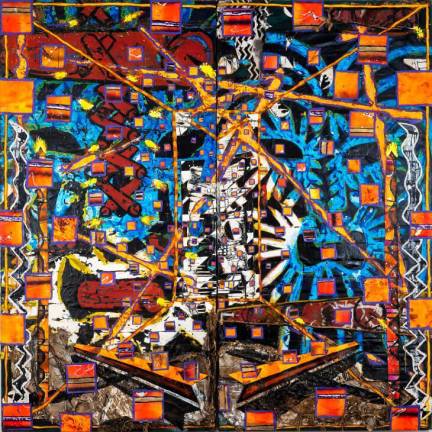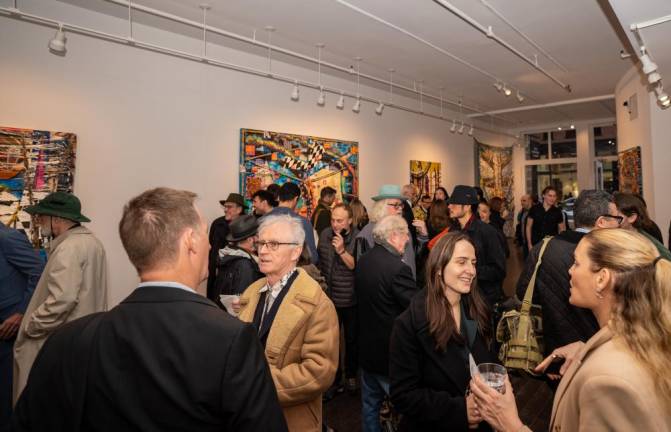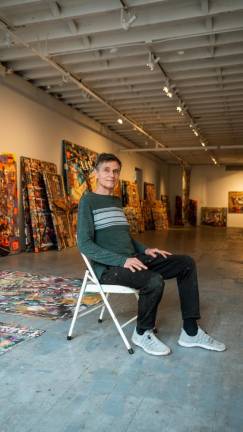Seafaring artist Reid Stowe solos around globe...and into new Soho Exhibit
Reid Stowe once spent over 1,100 days at sea without touching land and holds the record for the longest solo sea voyage at 846 days. Now his “Oceanic Feelings” exhibit has sailed into a solo show at prestigious Soho studio, Chase Contemporary at 413 W. Broadway through April 16th.
At just 5 years old, Reid Stowe predicted his future career as a painter and sailor. “I had big pieces of paper and I drew hundreds of little men and lots of little boats,” he said.
The now 71-year-old abstract painter, who has a floating boat studio docked in the Hudson River in Jersey City, says that making art inspires his adventures at sea. “All of this, you see, ties into my art, because creating art gives people visionary qualities and making the art gave me the vision that I could do this,” he said.
The North Carolina native built his first sailboat when he was just 21 years old and by his mid 20’s, had already sailed the Atlantic and Pacific Oceans and around Antarctica. In the early ‘80s, he moved to SoHo and immersed himself in the East Village art scene, socializing with notable names like Julian Schnabel, Jean-Michel Basquiat and Keith Haring.
Stowe’s unique resume includes making the longest sea voyage in history, a 3-year nonstop sail across the globe in a schooner he designed and built when he was just 26 years old. He also took a 1,152-day trip on the ocean with eight others in a “life and death situation” to simulate a mission to Mars to better understand the effects of not touching land for that long amount of time. The highly accomplished seafarer also holds the record for the longest solo sea voyage in history, when he did not see land or another human for 846 days on his journey through Australia.
His solo show “Oceanic Feeling,” runs until April 23 at Chase Contemporary gallery in SoHo. It features paintings that are inspired by his unique life and incorporate the earth and includes materials like sand, woodchips and gold leaf.
Tell us about the art scene here in the ‘80s.
The main art scene was in SoHo and then it picked up in the East Village. And there was the whole new graffiti art scene and that was such a contrast. Before that, the only art scene was up on 57th Street, so it was a different crowd and type of artist. And when it moved down to SoHo, then it got to be more like a bohemian scene. And when the East Village scene started in the early ‘80s, it was a kind of wild graffiti art scene with all the artists making art in the street. We were also using empty buildings and doing big art shows in the empty buildings and on the street and around Tompkins Square Park and hanging art there in the park. It was just a very social and wild time for artists. You knew where all the artists went. Everybody had big afterparties at the nightclubs. And it was just quite a friendly scene.
I got to know all the artists in that scene because everyone was partying together. Basquiat, Keith Haring, Richard Hamilton, who was famous for doing his black splatter figures, Mark Kostabi and Rick Prol. And some of those artists came to my opening last Thursday. So it was great to see such a crowd from way back that I’ve known for so long.
When did you start working on the boat?
I built my first boat when I was 20 years old. By the time I was 20, I knew what it was to be a shaman. As a teenager, I was introduced to sailing alone on the ocean as a path of empowerment by the first man to sail around the world without stopping and his friends. The whole idea that you could go into the wild of nature and be alone and pray to the universe that you would be an empowered person. And that happened to me at 19. So when I went to build my first boat, named “Tantra,” which is a very extreme form of yoga ... by the time I finished sailing the smallest boat twice across the Atlantic Ocean and had all kinds of adventures like you can’t imagine. I was 24 years old when I had the plans for what I called the ultimate long-distance heavy weather sailboat, meaning a sailboat that would be built so she could go anywhere in the world and ride out the biggest storms. So I did that at 24 and launched the boat at 26.
You made the longest sea voyage in history at the age of 26.
I realized I was in the unique position of being able to do the longest sea voyage in history to sail and keep sailing on the sea without stopping. When I launched the boat in the spring of ’78 when I was 26, I went on to sail the boat and do these great adventures and then ended up doing the longest sea voyage in history.
In addition to all of your incredible feats, you were also the first person to use GPS as a drawing tool. Explain what that means.
I got the idea that I was going to do this voyage as a preparation for going to sea for a thousand days. I wasn’t quite ready, but to go to sea for 200 days was a good start. I looked at the winds and currents of the world, which I had already studied all my life. And I said, “Here in the South Atlantic, I won’t run into a hurricane season.” And I said, “I could draw a sea turtle here.” So I drew a sea turtle on my map that had the weather markings and I said, “I could follow the winds and currents and I can draw this sea turtle.” So I drew it on a map and before I left I called the Associated Press and they came to the boat and I showed them the map.
And I said, “When I get to the equator, I’m going to change course and draw the head. When the head is drawn, I’m going to change course again and draw the shell. Then I’m going to change course again and draw the flipper.” So they took the photograph of my map and they published it in the story and it went worldwide and people could look and see that I was drawing a sea turtle with the course that I was going to sail. And it took 200 days and it was a real big step in my life as a sailor and an artist to do that.
Tell us about your work with NASA and your trip to simulate a mission to Mars.
I read that President Bush, at the end of the ‘80s, said that we must send humans to Mars. It was going to be eight people, multinational, men and women, and the trip was going to take about three years. People are going to be stuck inside their little spaceship, just like a boat, in a life and death situation where they’re isolated from all of society. And I realized that I had already done something similar on my Antarctic expedition in 1987. So I wrote a paper titled, “Seafarers of Today Provide a Role Model for Spacefarers of Tomorrow,” and teamed up with the NASA psychologists who were studying to prepare people to go to Mars.
I went with eight people, five nationalities, two women. We were stuck on that boat together for five months, life and death situation. I talked to the crew before we left and said, “Look, this is so dangerous. We could die. Are you ready to die?” And I made sure that each crew member understood this and really wanted to do it. My best man was shouting, “We’re all gonna die,” when the wind almost crashed us on icebergs.
For further info, check www.marsoceananalogs.com


